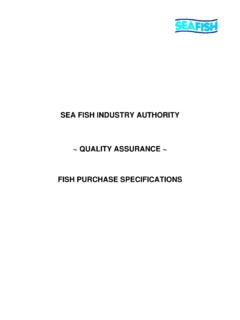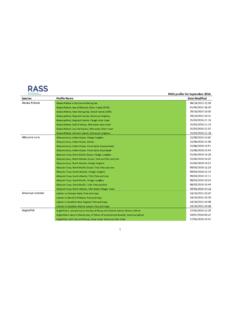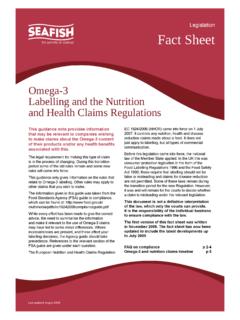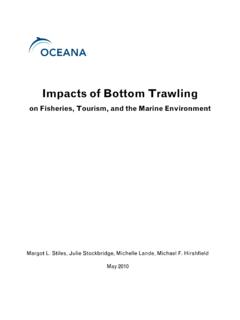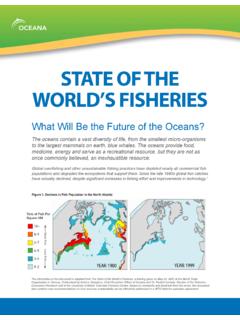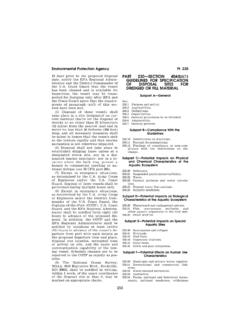Transcription of INTRODUCTION - Seafish
1 Seafish 18 Logie Mill, Logie Green Road, Edinburgh EH7 4 HST: +44 (0)131 558 3331 F: +44 (0)131 558 1442 E: Origin Way, Europarc, Grimsby, Lincs DN37 9 TZT: +44 (0)1472 252 300 F: +44 (0)1472 268 792 E: an industry used to a changing environment, fishing has adapted over the years in order to remain a sustainable industry. Nowhere is this more evident than fishing gear. Once created to increase production, the environment is now at the heart of innovation in gear technology to support the management of fish stocks and reducing impact on the marine environment. Years and years of research and development has gone in to gear technology, allowing fishermen to be more selective with the catch. Yet, most people never get the opportunity to see fishing gear in operation - they have very little appreciation of how it works and what it actually looks like when it is fishing.
2 Fishermen will know and understand their own gear very well, but even they rarely see what happens with the gear beneath the water, usually having to rely on the resulting catch to gauge how the gear is publication, produced by Seafish , provides some basic knowledge of how fish are caught using a range of fishing methods. So if you are keen to see how types of gear work or just interested in the way we fish around the UK, let it help to take some of the mystery out of the fishing gear that we normally see piled up at the harbourside or on the stern of a fishing this guideThis publication deals mainly with UK fisheries with reference to other fisheries throughout the world that supply wild-caught fish and shellfish into the UK the gears are described to cover the basic concepts of each fishing method.
3 There will be many regional variations of the generic design and method of operation used around the UK and in other countries. The basic principles for all the gear variations should be very gear dimensions used in this publication are based on the average general use of the various gears. In certain areas there may be fishermen who have refined their gear to suit local conditions and work it efficiently outside these general more information?For the latest information on fishing gear and selectivity visit the Seafish Gear Database at The database is an online portal detailing all common fishing gears and selectivity devices used in commercial fisheries throughout the UK and Europe. It has full descriptions of the gear, illustrations, video clips and links to scientific trials and NETS 5 PURSE SEINE 13 BEAM TRAWL 17 DEMERSAL TRAWL 25 MULTI-RIG trawling 51 PELAGIC TRAWL (SINGLE AND PAIR) 63 GILL NETS 69 LINES 77 POTS AND TRAPS 85 FISH SPECIES IN THE WATER COLUMN 94 FISHING GEAR IN THE WATER COLUMN 96 GLOSSARY OF TERMS 9845 SEINE NETS6 Seine netsFig Beach seiningFig Scottish seining7 There are three main types of seine nets; beach seine, anchor or Danish seine, and fly dragging, also called fly shooting or Scottish netting is a direct descendant from beach seining, one of the oldest fishing methods with indications that early forms were used in ancient times.
4 This progressed to using longer ropes to get further off shore, then being shot offshore using a sailing vessel and the ropes and net hauled by hand with the vessel at anchor. The seine net methods that we know today are claimed to originate from Denmark, around 1850, where it was first used to catch plaice. With the coming of power-driven boats with winches on board, longer ropes and larger nets could be worked with smaller crews. In the 1920s, Danish anchor seining was introduced to Scotland, but they quickly dispensed with the anchor by using the vessel s own power to maintain its position while hauling the ropes and net. This method, called fly shooting, proved more successful for catching round-fish (whiting, haddock, cod, etc.). The main principle of seine net is that long lengths of ropes are laid on the seabed in a circular shape with the net half way round the circumference of the circle.
5 The ropes are slowly closed up, and as they move over the seabed they herd demersal fish into the are three main types of seine nets; beach seine, anchor seine and Scottish SEINEThis was probably the beginning of seine net fishing. In this method, a net is shot from the shore in a semi-circular shape using a small boat or, in shallow water, by hand, by wading through the water. Once the second end of the net is ashore again the two ends are hauled together and the net is hauled back on to the shore and the catch removed from the net. Nowadays, this method is used in many small scale fisheries. In SEINE NETSthe UK, it used to be common place in estuaries for targeting migrating salmon and sea trout, but this has almost died out, only being used in one or two locations in Scotland now.
6 It is used in a few other areas of the UK to target bass or sandeels for bait. Overseas, it is used in many of the artisanal fisheries to target small pelagics that shoal up close to shore. Fig Beach SEINE (Fly dragging, fly shooting)Scottish seine is a very skilful operation requiring extensive knowledge in locating fish within the grounds, accurate rigging of the gear, and consideration of tidal streams in relation to the gear throughout the shooting, towing and hauling operation. Fig Scottish modern seine net vessel can work anything up to 14 coils of rope each side of the net. Each coil consists of 220 metres (120 fathoms) of lead cored, abrasion resistant rope, from 19mm up to 32mm diameter depending on the size of vessel. One end of the ropes is shot, with a dhan (buoy) attached.
7 The vessel then steams round in a circular shaped course shooting one side of the ropes, one end of the net is attached to the ropes and the net shot away half way round the circle. The other side of ropes is attached to the other end of the net and they too are shot away with the vessel completing the circle close to the dhan, picking it up, leading both ropes to the winch and starting to tow the gear. The vessel will tow until strain is on both ropes, then engage the winch to begin heaving slowly. At this stage the vessel is moving slowly ahead, the winch is used to haul the seine net ropes in, slowly at first, and speeding up as the gear is closed up. As the ropes are hauled in, the vessel will gradually start to be hauled astern towards the net even although the engine is still trying to drive the boat ahead.
8 Once most of the ropes are hauled in, the gear is almost closed up and the net is hauled to the stern of the vessel, hauled on board and the cod-end emptied on the side deck of the boat or nowadays into a reception hopper. The gear is 8 Seine netsFig Anchor seining9ready to be shot away again, and the skipper will manoeuvre the boat to the next position to shoot the gear. Each hauling and shooting routine will take about an hour and a half to three efficiency of seine net very much depends on the skipper s experience and ability to keep the gear square and to get the speed of hauling correct at the various stages, taking into account the weather, the tidal conditions, the behaviour of target species and the depth of water. At one time (1950s to 60s), Scottish seine net was probably the main fishing method in Scotland for demersal fish.
9 At this time, there would have been only a handful of vessels in England using the method; anchor seining was still their favoured method. Over the years, many vessels have changed to trawling , and up to year 2000 there would have been only a few vessels left using Scottish seine in the UK. However, in recent years, there has been a small resurgence in seine netting, with a few new vessels being built specifically for this method of fishing. This is probably because seine netting is a very fuel efficient method of fishing, and it gives the skipper the opportunity to land fish to the market in prime condition, thereby securing top prices on the market. The main areas of operation in the UK are North and North East Scotland, and Shetland, but only by a few vessels.
10 Over the years, many Scottish vessels have turned to pair seining. This has developed more as a version of pair trawling with these vessels, and will be covered in the pair-trawl section of this SEINEA nchor seine is handled in a similar way to Scottish seine, the main difference being that when the dhan is shot away the vessel also drops a large anchor to which the dhan is attached. They will shoot the ropes and net as in Scottish seine, but when the boat returns to the dhan, the crew pick up the other end of the seine net ropes and lead them to the winch, but they will also moor the boat to the anchor. The seine net ropes and net are now hauled in to the anchored vessel, with the anchor preventing the vessel being hauled astern. Once the gear and catch is on board, the skipper will prepare for the next shot, usually without lifting the anchor.
